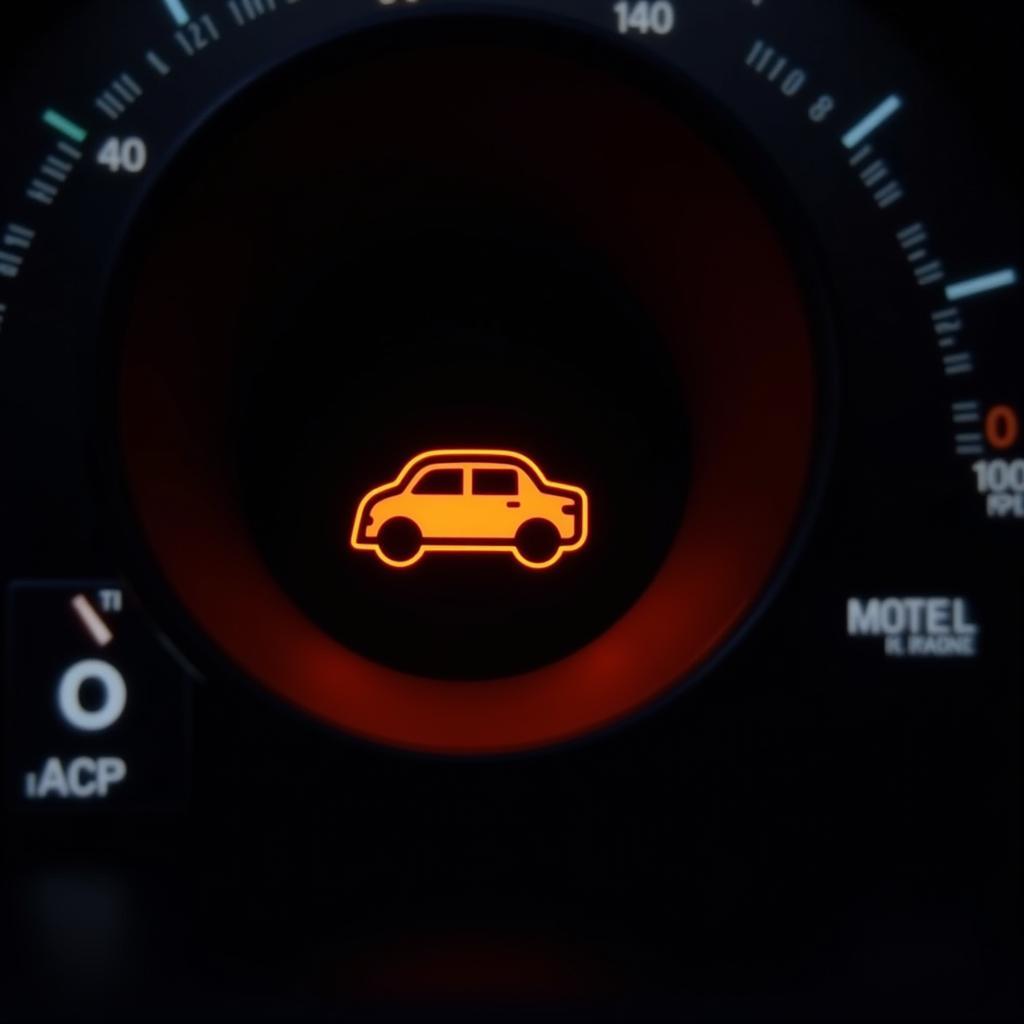The “Diagnostic Tool Car Icon” is more than just a symbol on your dashboard. It’s a beacon, signaling a potential issue with your vehicle and urging you to take action. This seemingly simple icon is your gateway to understanding your car’s health, connecting you to a world of sophisticated diagnostics that can pinpoint problems and guide repairs.
Decoding the Dashboard: What the Diagnostic Tool Icon Means
![]() Diagnostic Tool Car Icon on a Car Dashboard
Diagnostic Tool Car Icon on a Car Dashboard
When the diagnostic tool car icon illuminates, your car is communicating. It’s telling you that the onboard computer system, often referred to as the Engine Control Unit (ECU), has detected a potential problem. This problem could range from something minor, like a loose gas cap, to a more serious issue within the engine or transmission.
While the appearance of the icon can vary slightly between car manufacturers, it typically resembles a car outline with an engine schematic or an exclamation point. Regardless of the specific design, the message is clear: it’s time to investigate further.
Unlocking the Secrets: How Car Diagnostic Tools Work
Modern vehicles are equipped with an On-Board Diagnostics (OBD) system. This system continuously monitors various sensors and components throughout the car, collecting data on performance and emissions. When a problem is detected, the OBD system stores a Diagnostic Trouble Code (DTC) in the ECU’s memory.
This is where car diagnostic tools come in. These tools, ranging from handheld scanners to sophisticated software used by mechanics, connect to your car’s OBD system through a standardized port, usually located under the dashboard.
Once connected, the diagnostic tool can read the stored DTCs, providing valuable insights into the potential source of the problem. Think of it as translating your car’s language, transforming cryptic codes into understandable information.
From Simple Scanners to Advanced Software: Types of Diagnostic Tools
The world of car diagnostic tools offers a wide range of options to suit various needs and expertise levels:
- Basic Code Readers: These affordable handheld devices are perfect for DIY enthusiasts. They can read and clear basic DTCs, giving you a general idea of the issue.
- Advanced Scan Tools: Used by professional mechanics, these tools offer more in-depth diagnostic capabilities, including live data streaming, actuator tests, and access to manufacturer-specific information.
- PC-Based Diagnostic Software: These software programs offer the most comprehensive diagnostic features. They connect to your computer via a cable or wirelessly, providing advanced functionalities like ECU programming and coding.
Choosing the right tool depends on your technical skills, budget, and the depth of diagnostics required.
Beyond the Code: The Importance of Expert Interpretation
While car diagnostic tools provide valuable data, it’s crucial to remember that they don’t offer a definitive diagnosis. The DTCs act as clues, pointing towards potential areas of concern. Interpreting these clues and arriving at an accurate diagnosis requires mechanical knowledge and experience.
For example, a single DTC related to the oxygen sensor could have multiple underlying causes. A skilled mechanic will use the diagnostic information as a starting point, conducting further inspections and tests to pinpoint the root of the problem.
Empowering Car Owners: The Benefits of Car Diagnostics
Understanding car diagnostics empowers you as a car owner. Here’s how:
- Early Problem Detection: Regular diagnostics can help identify potential issues before they escalate into major repairs.
- Informed Decision Making: Accurate diagnostic information allows you to make informed decisions about repairs, avoiding unnecessary expenses.
- Improved Communication with Mechanics: Knowing the potential cause of the problem facilitates clear communication with your mechanic, ensuring efficient and effective repairs.
The diagnostic tool car icon may seem daunting at first, but it’s a valuable ally in maintaining your car’s health. By understanding its meaning and embracing the power of car diagnostics, you can enjoy a smoother, safer, and potentially more affordable driving experience.
FAQs: Common Questions About Diagnostic Tool Car Icons
-
Q: Can I continue driving with the diagnostic tool car icon on?
A: While the severity of the issue is unknown, it’s best to get your car checked by a mechanic as soon as possible. Continuing to drive could potentially worsen the problem.
-
Q: Will the icon go away on its own?
A: In some cases, minor issues might resolve themselves, and the icon might turn off after a few driving cycles. However, it’s still recommended to have the system checked for stored DTCs.
-
Q: Do I need to take my car to a dealership for diagnostics?
A: Reputable independent mechanics also have access to sophisticated diagnostic tools and can provide accurate diagnoses and repairs.
Need Help? We’re Here for You!
Do you have more questions about car diagnostics or need assistance with your vehicle? Don’t hesitate to reach out! Our team of expert car diagnostic technicians is available 24/7 to provide support and guidance. Contact us via WhatsApp at +1(641)206-8880 or email us at cardiagtechworkshop@gmail.com. We’re here to help you keep your car running smoothly.


Leave a Reply